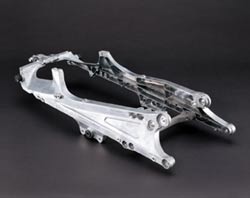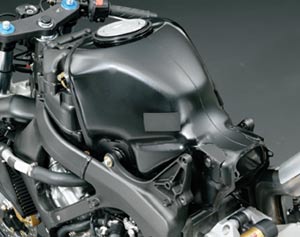![]()
![]()
 The
new CBR600RR's revolutionary new hollow die-cast aluminum frame is constructed
of nine pieces (1 steering head, 2 engine hangers, 2 pivot plates, and 4
interconnecting sections) all welded together to form one solid, organic
whole.
The
new CBR600RR's revolutionary new hollow die-cast aluminum frame is constructed
of nine pieces (1 steering head, 2 engine hangers, 2 pivot plates, and 4
interconnecting sections) all welded together to form one solid, organic
whole.
The CBR600RR's frame positions the rider closer to the steering head and almost directly above the machine's center of mass, a position made possible by an unprecedented redesign of the CBR's fuel tank. The overall frame rigidity is comparable to the current F4i. However, lateral rigidity around the steering head was increased to better stand up to the stresses put upon it by the front suspension as the bike flicks from side to side.
The RR's torsional rigidity was reduced slightly near the center of its frame to lighten and ease handling in quick maneuvers, and enhance wheel tracking to help the machine better settle into its line through the corners.
 Say
goodbye to the days of welded aluminum/steel box tube Subframes, and greet the
first cast aluminum subframe.
Say
goodbye to the days of welded aluminum/steel box tube Subframes, and greet the
first cast aluminum subframe.
A conventional welded steel or aluminum seat rail, constructed primarily for lightness and strength, would require that the CBR's underseat exhaust system be bent to fit its narrow design parameters, and as a result would likely have an adverse affect on engine performance.
Additional manufacturing time and costs were reduced by only requiring five pieces in the subframe construction: the two rails mounted to the frame and three bolted-in cross-members that provide assured lateral strength and rigidity. The two rails themselves curve inward to bolt together at the rear, providing added structural strength without the need for expensive, time-consuming welds.
 One
of the most impressive, but least recognizable features of the CBR600RR is the
completely redesigned fuel tank. Covered by a simple plastic shell, the
new fuel tank produces significant handling improvements through a more
centralized mass and lower center of gravity.
One
of the most impressive, but least recognizable features of the CBR600RR is the
completely redesigned fuel tank. Covered by a simple plastic shell, the
new fuel tank produces significant handling improvements through a more
centralized mass and lower center of gravity.
The traditional location over the engine-although often one of the most attractive points of focus in a motorcycle's design-invariably concentrates a large lump of shifting/sloshing inertial weight at the highest point in the bike's form.
The change in fuel tank shape permits the rider's seating position to be moved a full 70mm forward relative to the steering head, resulting in a smaller form with its mass more effectively centralized around its rolling axes. Next, the centralized positioning of the fuel's weight results in a lighter and more responsive handling feel that enhances quick changes in direction while remaining essentially neutral, regardless of how much fuel it is carrying.